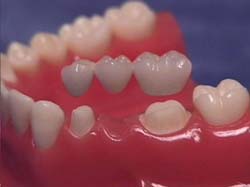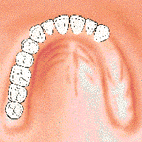Dental Bridges Matthews NC Restore Gaps for a Complete Smile
Do you have missing teeth? If yes, then it is recommended to consider consider getting a dental bridge. A dental bridge is a prosthetic device used to replace one or more missing teeth. It consists of artificial teeth, known as pontics, which are anchored in place by dental crowns attached to the neighboring natural teeth or dental implants. Dental bridges Matthews NC offer a reliable and aesthetically pleasing solution to fill gaps caused by missing teeth, restoring the appearance, functionality, and overall oral health of individuals.
Contact us for more information about dental bridges or book your appointment today.
Assessment and Consultation
The dental bridges service begins with a comprehensive assessment and consultation with a dental professional. During this stage, your oral health will be evaluated, and the specific needs and expectations will be discussed. Our dentists will examine the surrounding teeth, gums, and bone structure to determine if a dental bridge is the right treatment option for you.
Preparation of Abutment Teeth
To anchor the dental bridge securely, the abutment teeth (the neighboring teeth on either side of the gap) need to be prepared. The dentist will reshape these teeth by removing a small amount of enamel to accommodate the dental crowns that will support the bridge. In some cases, if the adjacent teeth are not healthy or available, dental implants may be used as support.
Impressions and Shade Selection
After preparing the abutment teeth, impressions of your mouth will be taken. These impressions serve as a basis for the dental laboratory to fabricate a custom bridge that fits your mouth precisely. During this visit, our qualified dentist will also help you select the shade of the bridge to match the color of your natural teeth, ensuring a seamless and natural-looking restoration.
Temporary Bridge Placement
While your permanent bridge is being created in the dental laboratory, a temporary bridge will be placed to protect the prepared teeth and maintain your smile’s appearance and functionality. The temporary bridge will be removed once your permanent bridge is ready for placement.
Bridge Fitting and Adjustment
Once your custom dental bridge is fabricated, it will be carefully fitted and adjusted to ensure proper fit, alignment, and comfort. The dentist will make any necessary modifications to ensure that your bite is balanced and that the bridge feels comfortable in your mouth. Attention to detail during this step is crucial to achieving optimal functionality and aesthetics.
Permanent Bridge Placement
After the fitting and adjustment, your permanent bridge will be bonded into place. The dental crowns on the abutment teeth or the implants will be cemented, and the artificial teeth will fill the gap, completing your smile. The dentist will ensure that the bridge is securely attached and that your bite is functioning correctly.
Post-Treatment Care and Maintenance
Caring for your dental bridge is essential to maintain its longevity and functionality. Good oral hygiene practices, including regular brushing and flossing, are necessary to keep the bridge and surrounding teeth clean and healthy. Routine dental check-ups and professional cleanings will allow the dentist to monitor the condition of the bridge and address any issues promptly.
Fixed Dental Bridges
A fixed partial denture (FPD), sometimes called a “fixed bridge” or simply a “dental bridge” is the use of multiple dental crowns splinted together to replace a missing tooth or teeth. In a situation where you have a missing tooth and there are healthy teeth on either side of the space, a fixed dental bridge can provide a good solution to replace the missing tooth.
An FPD or dental bridge is made by preparing the adjacent teeth for crowns. The process occurs in the same way and the steps are quite similar. There are usually several trial steps in between to verify the fit which are not needed for most single crowns. The supporting teeth are called the ‘abutments’. The dummy teeth in between are called ‘pontics’. The design and preparation are exacting and it is important to try and determine the strength and health of the teeth on either side of the space. This is because we are asking those teeth to now carry the weight of the missing teeth as well as their own.
The FPD or “dental bridge in Matthews” usually has a cast metal substructure for strength though there are now some ceramic substructures that can carry a substantial biting load. The design of the underside of the pontic tooth can vary. Sometimes it is bullet shaped to make it seem as if the fake tooth is emerging from the gums. Other times it may have a small gap or overlap for clearance and to enable cleaning underneath.
Once cemented in place, the dental bridge looks and feels much like your own teeth. One exception is that you will not be able to floss between the bridged teeth normally. Instead, you will need to use floss threaders or an inter-dental brush to clean under the pontic.
When a Bridge is Not Possible
These are just a few situations where a fixed dental bridge would not be an acceptable treatment choice. In the first picture on the left, the patient has a long span of 3 missing teeth which need to be replaced. This is too long of a gap to try to span. In the middle case, there is only “land” on one side and nothing to support the dental bridge from the back side. On the right side, again, there is simply too long of a gap in the front to try and fill. The adjacent teeth on either side will not support such a high load without fracturing. For these cases, we usually begin to look at alternatives like dental implants or removable partial dentures
This is the end result of too much stress on an abutment tooth. Unfortunately, when this happens, the whole bridge need to be removed, the fractured root extracted and an alternative needs to be treatment planned and fabricated.
This is what usually happens when you don’t replace a missing tooth. It is not possible for us to predict, once you have lost a tooth, exactly to what extent this will occur. What results, however, is a situation in which the misaligned teeth must first be corrected before a bridge can be fabricated. Note how the bite is no longer level and the abutment teeth are no longer straight up and down.
Dental bridges in Matthews can be as simple as three teeth or as complicated as a whole arch of teeth. We can use segmented portions keyed together or one long span. Many times, if teeth have compromised bone support, we can use a dental bridge to link them together and help support one another. The design, however, must be carefully planned to avoid over-stressing the abutments. Another consideration to joining the teeth is that if any one tooth in a key spot breaks or fails to carry the load, the whole segment that rests on it may need to be replaced. We are always happy to discuss your options and encourage you to think carefully about the treatment choices we may recommend.










